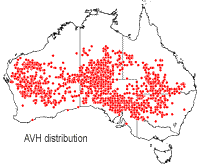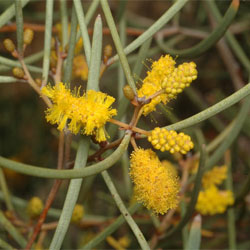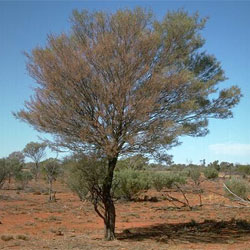Acacia aneura
Mulga, Mulga Wattle
Acacia aneura F.Muell. ex Benth.
 Acacia aneura, commonly known as the Mulga Wattle, is a member of the Fabaceae family. It is widely distributed throughout all mainland states of Australia, with the exception of Victoria. In some arid and semi-arid inland areas, A. aneura is such a dominant and conspicuous element of the landscape it has given rise to the terms ‘mulga country’, or ‘mulga lands’. The species exhibits a large degree of variability, with a single stand often containing several distinct variants. Ten varieties of A. aneura are currently recognized, however others will probably be described with further investigation.
Acacia aneura, commonly known as the Mulga Wattle, is a member of the Fabaceae family. It is widely distributed throughout all mainland states of Australia, with the exception of Victoria. In some arid and semi-arid inland areas, A. aneura is such a dominant and conspicuous element of the landscape it has given rise to the terms ‘mulga country’, or ‘mulga lands’. The species exhibits a large degree of variability, with a single stand often containing several distinct variants. Ten varieties of A. aneura are currently recognized, however others will probably be described with further investigation.
A. aneura grows up to 10 meters as single-stemmed tree in higher rainfall areas, but is a 2 to 3 meter high shrub in dry situations or on very shallow soils. Phyllodes (a phyllode is a leaf whose blade is much reduced or absent, and whose petiole and rachis have assumed the functions of the whole leaf). are needle-like and 3 to 11 centimeters long, with very fine hairs giving the foliage an attractive silvery-grey appearance. Small bright-yellow flowers form spikes 1.5 to 2 centimeters long. Flowering may occur at any time of the year following suitable rains, however the principle flowering time is between March and October, with a peak in May. Thin, flat membranous pods, 2 to 5 centimeters long contain edible dark brown seeds.
Unlike many acacias which are relatively short-lived, A. aneura has a life-span of over 50 years. It has the capacity to withstand prolonged drought owing to sophisticated arrangement of phyllodes and branches which channel rainwater to the stem and onto the ground directly to its deep taproot. Seedlings of only 10 centimeters high have been found to have taproots reaching 3 meters into the ground, in addition to an extensive lateral root system in the top 30 centimeters of the soil.
Although A. aneura is a hardy plant, the best results from cultivation will be achieved when growing conditions are maintained similar to those occurring throughout its natural distribution. Soils supporting A. aneura are usually sands or sandy loams which permit easy infiltration of water, and the plants may be damaged by water saturated soils. Thus, it is not recommended for planting on heavy clay soils, in turf areas or with an understory of high water demanding plants. Supplementary watering is generally not necessary; however it can significantly improve growth rates. For example, in central Australia planted specimens receiving an average of 370 millimeters of rainfall per year have been found to grow to multi-stemmed shrubs of 3 meters tall in 10 years, as opposed to cultivated specimens receiving regular irrigation which reached 10 meters tall within the same timeframe. Fertilizer application is unnecessary as A. aneura is well adapted to low levels of soil nutrients. Other maintenance regimes will be dependent upon the purpose of the planting. If a hedge or screen planting is desired, a more shrub-like growth habit can be achieved by reducing or eliminating pruning.
Throughout its natural distribution A. aneura experiences hot summers and cool winters with light morning frosts. It is therefore frost tolerant to about 9 oC and prefers full sun to some light shade. A. aneura can be easily propagated from fresh, scarified and pre-soaked seeds which are sown at 21 to 26 oC, and should germinate in less than a month.
Text by Kylie Singh (2010 Student Botanical Intern)
Name Meaning: Acacia aneuraAcacia – from the Greek word ‘akis’, meaning point or barb aneura - from the Greek words 'a' (not) and 'neuron' (a nerve), in allusion to the absence of conspicuous veins on the phyllodes |
Acknowledgments
Taylor, D. (2010) ANBG Horticulturalist
![An Australian Government Initiative [logo]](/images/austgovt_brown_90px.gif)



